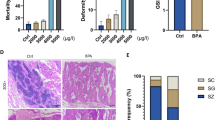Abstract
Tetrabutyltin is the starting material of the tributyltin and dibutyltin compounds. These tin compounds are starting materials for a wide range of organotin compounds used as stabilizers for PVC, biocides, fungicides, and anti-biofouling agents. It is commonly known that some of the environmental chemicals affect the human endocrine system. Since the 1970s, the harmful effects of endocrine disrupting chemical (EDC), Tetrabutyltin (TTBT) have been extensively studied. In the present study, we analyzed the effect of TTBT on gene regulation and expression of genes in mouse germ cells. Mouse germ cells were treated with TTBT for 3 and 24 hrs, and global gene expression was analyzed by using customized Agilent mouse arrays. We identified genes that were >2-fold differentially expressed in TTBT-treated cells than control cells (P<0.05) and analyzed their functions through Gene Ontology analysis. In a total number of 687 genes, there was differential expression between TTBT-treated and control cells. About 471 and 350 genes exhibited 2-fold (P<0.05) increased or decreased expression at 3 and 24 hrs, respectively. Additionally, in 134 genes, common and significant changes were observed in two-time series. Functional analysis of these genes showed that there were significant enrichments in some of the processes related to the reproduction such as, female gamete generation, homeostatic process, cell differentiation, response to chemical stress and reproductive process. In conclusion, the present study provides an insight on the effects of TTBT on mouse germ cells. Furthermore, it also increases our knowledge on the underlying molecular mechanisms on the adverse effects of organotin on the reproductive system.
Similar content being viewed by others
References
Fent, K. Ecotoxicology of orgatonin compounds. Crit. Rev. Toxicol. 26, 3–117 (1996).
Boyer, I. J. Toxicity of dibutyl, tributyltin and other organotin compounds to humans and to experimental animals. Toxicology 55, 253–298 (1989).
Piver, W. T. Organotin Compounds: Industrial applications and biological investigation. Environ. Health Perspect. 4, 61–79 (1973).
Horiguchi, T., Shiraishi, H., Shimizu, M. & Morita, M. Effects of triphenyltin chloride and five other orgatonin compounds on the development of imposex in the rock shell. Thais clavigera. Environ. Pollut. 95, 85–91 (1997).
The European Commission by Risk & Policy Analysts Limited. Risk assessment studies on targeted consumer applications of certain organotin compounds. Final Report prepared for the European Commission RPA. (2005).
Matthiessen, P. & Gibbs, P. E. Critical appraisal of the evidence for tributyltin-mediated endocrine disruption in mollusks. Environ. Toxicol. Chem. 17, 37–43 (1998).
Zachariadis, G. A. & Rosenberg E. Speciation of organotin compounds in urine by GC-MIP-AED and GCMS after ethylation and liquid-liquid extraction. J. Chromatogr. B. Analyt. Technol. Biomed. Life Sci. 877, 1140–1144 (2009).
Okada, Y. et al. Tri-n-butyltin-induced change in cellular level of glutathione in rat thymocytes: a flow cytometric study. Toxicol. Lett. 117, 123–128 (2000).
Nuwaysir, E. F., Bittner, M., Trent, J., Barrett, J. C. & Afshari, C. A. Microarrays and toxicology: the advent of toxicogenomics. Mol. Carciong. 24, 153–159 (1999).
Aardema, M. J. & MacGregor, J. T. Toxicology and genetic toxicology in the new ear of “toxicogenomics”: impact of “-omics” technologies. Mutat. Res. 499, 13–25 (2002).
Cory, A. H., Owen, T. C., Barltrop, J. A. & Cory, J. G. Use of an aqueous soluble tetrazolium/formazan assay for cell growth assays in culture. Cancer Communications 3, 207–212 (1991).
Huang, D. W., Sherman, B. T. & Lempicki, R. A. Bioinformatics enrichment tools: paths toward the comprehensive functional analysis of large gene lists. Nucleic Acids Res. 37, 1–13 (2009).
Lu, B. et al. A mutation in the inner mitochondrial membrane peptidase 2-like gene (Immp2l) affects mitochondrial function and impairs fertility in mice. BiolReprod. 78, 601–610 (2008).
Roverts, A. E. et al. Neutralization of endogenous vascular endothelial growth factor depletes primordial follicles in the mouse ovary. BiolReprod. 76, 218–223 (2007).
Gakunga, P. et al. Hyaluronan is a prerequisite for ductal branching morphogenesis. Development 124, 3987–3997 (1997).
Fan, H. Y., Liu, Z., Johnson, P. F. & Richards, J. S. CCAAT/enhancer-binding proteins (C/EBP)-α and -β are essential for ovulation, luteinization, and the expression of key target genes. MolEndocrinol. 25, 253–268 (2011).
Yessoufou, A., Hichami, A., Besnard, P., Moutairou, K. & Khan, N. A. Peroxisome proliferator-activated receptor alpha deficiency increases the risk of maternal abortion and neonatal mortality in murine pregnancy with or without diabetes mellitus: Modulation of T cell differentiation. Endocrinology 147, 4410–4418 (2006).
Cho, H. S. et al. A relationship between miRNA and gene expression in the mouse Sertoli cell line after exposure to bisphenol A. BioChip J. 4, 75–81 (2010).
Kim, J. S. et al. Array2GO: a simple web-based tool to search gene ontologyfor analysis of multi genes expression BioChip J. 4, 320–335 (2010).
Author information
Authors and Affiliations
Corresponding author
Rights and permissions
About this article
Cite this article
Yu, S.Y., Kim, S.J., Ha, JM. et al. Regulation of gene expression in mouse germ cells upon exposure to tetrabutyltin. Toxicol. Environ. Health Sci. 3, 179–184 (2011). https://doi.org/10.1007/s13530-011-0096-z
Received:
Revised:
Accepted:
Published:
Issue Date:
DOI: https://doi.org/10.1007/s13530-011-0096-z




